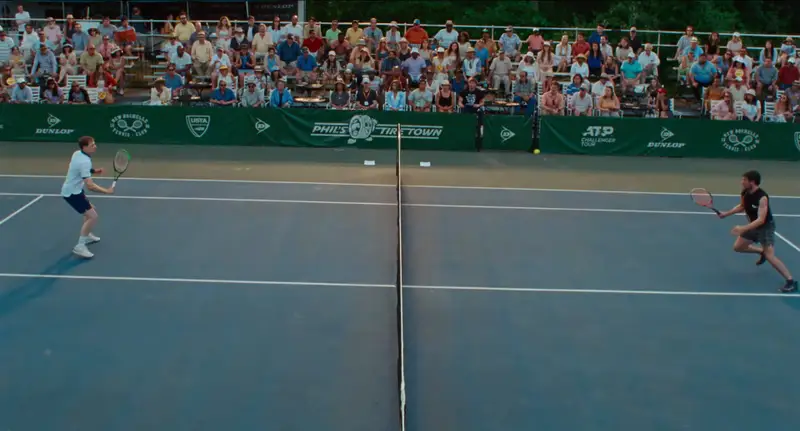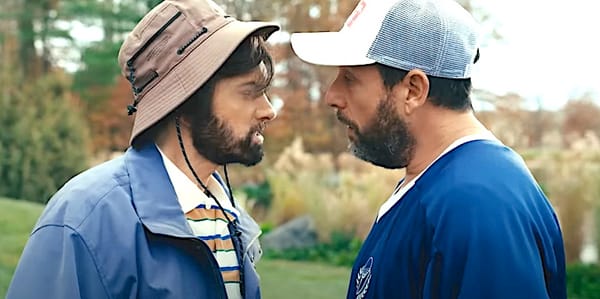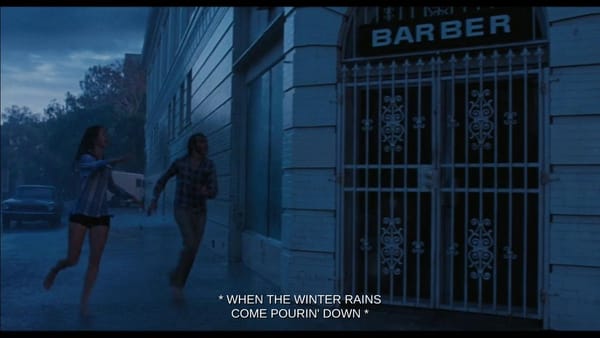Challengers (2024, Guadagnino)

TASHI: What am I?
PATRICK: In reality? A really, really, insanely hot woman. - Challengers
“Did you ever think there’s more to life than being really, really, really ridiculously good looking?” - Zoolander
No Bones & All, with its tearful elegy for a Midwest sunken in sand—Guadagnino’s best film—but a rueful pleasure in its own right. In Challengers, Guadagnino is toying with archetypal ideas and feelings: it is the most Freudian mainstream movie in some time, and while not as probing as the best, it charmingly utilizes the notions of Id, Ego, and Superego to poke at celebrity culture, class/ethnic identity, and Americana.
What interests me most–and what I find most enjoyable–about Guadagnino’s work is that he among the few celebrity film directors who are interested in the actual American landscape: dates at Applebee’s, used Taco Bell bags, “Hot in Herre” blaring at a party sponsored by Adidas. In other words, the cultural detritus that gets quickly forgotten but in small ways defines our relationships and the way we interact with the world. I mean, when’s the last time you heard “Hot in Herre”? The last time I heard it was at summer camp in 2004 as a gaggle of us walked by the sauna for grown-ups. And this is Guadagnino’s major accomplishment: depicting young people thrust prematurely into perceived adulthood--with a psychosexual twist.
The early hotel scene opens up the Freudian interpretation for me. We are drawn in as these pretty young people, with great verisimilitude, talk awkwardly about their early sexual experiences. One, Patrick, a Jew, is (fancifully) the less inhibited and discusses masturbation openly. The other, Art, a WASP, follows his lead and stutters and mumbles his way through an explication of his first (if you will) hands-on experience done in the company of Patrick. All the while, they are watched upon by a third party, Tashi. Tashi, a Black woman, subtly steers the ship of this conversation toward the homosocial and ultimately into the bed, where all three start making out and, of course, our two loverboys start kissing each other passionately while Tashi looks on proudly.
Prettiness is the doorway into deeper excavations of the above mentioned psychic agents. Patrick is the Id, that childlike compulsion toward desire and pleasure. Art is the Superego, full of should's and would's, in service to, you guessed it, the Ego, Tashi.
Structured well, credit goes to screenwriter Justin Kuritzkes for hanging such observations on the thin (nonexistent?) line between homosocial and homosexual. He brings the subtext of the sports movie into text via an erotically-charged tennis match and many flashbacks, some of which eclipse the present-day narrative. I'm thinking of the churro scene, or Art and Patrick training together, or Patrick and Tashi arguing in her dorm. Each of these scenes alone could be endlessly mined for their psychosocial content, but I'm going to direct my attention to one in particular: the sauna scene.
In the present day, Patrick and Art are sweating their stress out together in a sauna, the scene which is the key to the movie's relationship between WASP and Jew, I think. Art talks down (literally, he’s framed as above Patrick) to Patrick about tennis, but tennis is the thin pretense which they use to discuss everything else. It’s one more layer of competition for them: which identity has more social capital in the gaze of the domineering woman, whose gaze they need in order to feel satisfied, seen, in terms of their essence? The scorn these characters feel for each other, the condescension they share--this is the role race and class play in Challengers: Tashi is clearly the best tennis player, but she’s a Black woman and as such plays second fiddle to the Jew and the WASP. She says as much when sighing, with resignation, that she has to take care of her two white boys. In their scramble to gain that care, they ask, Who can out-condescend the other?
But this is strange, because movies don’t usually treat condescension as a subject, rather a modus operandi. They are condescending or not, not about the act of condescension.
The empathy comes in by way of Guadagnino’s scorchingly intimate framing; it’s clear he loves these characters. I see it in the wet dribbles of sweat. I see it in the beneath-the-ground perspective shot of our tennis players. I see it in the way Zendaya walks toward a high-speed camera tracking backward (at least twice, maybe more, but it got to the point where I asked, okay, what else you got?).
I think Guadagnino is scratching a major Demme itch here. Who can blame him? Demme is awesome. The piercing, head-on close-ups. The use of actors who look like real people. There's a poster of Something Wild hanging at Applebee's!
But unlike a Demme picture, Challengers is too long, and a bit too enamored with its own bag of tricks. The ending is nearly perfect, however. The challenge here is not for tennis supremacy or the affection of a really really insanely hot woman or even for the thinly veiled homosexual attraction between two men. The challenge is this: what part of your mind is the ego going to listen to; moreover, can it get these aspects of mind to act in concert? Art and Patrick, locked in a perpetual Sisyphean struggle for Tashi’s approval.
One must imagine the tennis player happy.




